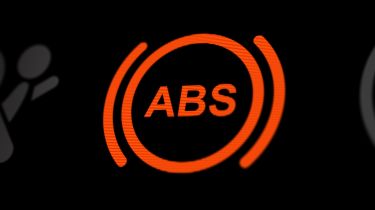What is ABS? Anti-lock braking systems explained
ABS is a vital part of any modern car's safety equipment. Here's everything you need to know

When you slam on the brakes in a modern car, you’ll probably feel a rumbling under the pedal and may even be treated to a dashboard warning light. While this may seem alarming, it’s actually your car’s anti-lock braking system working hard to stop your car as effectively and as safely as possible. So what is ABS and how does it work? We’re here to explain everything you need to know.
What are anti-lock brakes?
In simple terms, anti-lock braking systems use electronics to detect when one or more wheels are locking-up due to intense braking. Sensors on each wheel send a signal to a special electronic module and hydraulic pump that essentially apply and release the offending wheel’s brakes in rapid succession. This prevents the wheel from locking and causing a potentially dangerous loss of control.
An ABS system can apply the brakes on each wheel individually rather than all together, and it does this at much higher speeds than a driver could via the brake pedal.
Most people are aware that their car is fitted with ABS, but few know exactly what it does and how it works. ABS gradually appeared as a safety feature on new cars from the 1970s onwards, while EU law made it compulsory fitment on all cars built since 2004. If you drive a modern car it almost certainly has ABS fitted, and here’s everything you need to know about it.
How does ABS work?
ABS is an electronic brake control system that works in principle like cadence braking — where the driver rapidly pumps the middle pedal to maintain control in slippery conditions — only here it's much more effective.
ABS systems use sensors to detect when one wheel is rotating at a different rate to the others. If the sensor registers that a wheel is turning more slowly under braking, that's a sign the wheel is locking or about to lock. The dedicated electronics then reduce brake pressure by activating a relief valve, until it's equal with the other wheels.
If the wheel begins to lock again, the process is repeated, in the same way as pumping the brake pedal, although the electronics are sensitive enough that this can be repeated many times per second, whereas the process could only be replicated by a driver around once or twice a second at most. You can tell if your car's ABS system is working if you brake heavily and feel the brake pedal juddering under your right foot.
Modern ABS systems use a four-channel controller module that features individual sensors and relief valves on all four wheels. Older variations that feature one, two or three channels would have sensors across a front or rear axle, depending on the layout of the vehicle.
Does my car have ABS?
Virtually all new cars sold since 2004 have ABS fitted, but some older models dating all the way back to 1987 are also fitted with this technology.
When you switch on your car’s ignition or accessory power an ‘ABS’ warning light should briefly appear on the dashboard to indicate that the system is running a quick routine check. If this light does not appear, your car might not have it fitted. If the light stays on, however, this indicates a fault (we’ll explain more about this further down the page).
What are the benefits of ABS?
The improved braking provided by ABS is beyond doubt. Tests have shown that a car fitted with ABS braking on tarmac will stop in a far shorter distance than an identical non-ABS car, even if that car is being driven by somebody who is experienced in cadence braking.
The other benefit of ABS is that the car's steering will still work while using maximum brake pressure. In a car with locked wheels, the forward motion of the car will overcome the grip of the tyres and any steering lock that has been applied. But as the ABS-equipped car's wheels will still be rotating, the car will follow the direction of the steered wheels. This increased level of control drastically improves the safety of the car’s occupants.
How to stop safely with ABS
It can be slightly unnerving to feel your brake pedal juddering but, whatever you do, you must keep it applied and let the anti-lock brakes do their job.
Obviously, releasing the brake pedal will stop the braking entirely, and you simply won’t be able to pump the pedal fast enough to replicate the ABS effect. Your steering will still be fully functional while ABS is in operation, so be sure to concentrate on the road as you would do normally and steer as normal to avoid any collision.
ABS history
While the concept of non-locking brakes has been around for a number of years, the first truly effective anti-lock braking systems have been around since the 1950s, when British firm Dunlop first developed its Maxaret system for use in aviation.
This hydraulic system improved aircraft stopping distances when landing, as it all but eliminated the risk of wheels locking, even on ice, and it dramatically reduced flat spotting and tyre blow outs, too. It didn't take long for vehicle engineers to realise that the system could also be beneficial on cars.
The first road car to feature ABS was the 1966 Jensen FF. The FF was the first production sports car to feature four-wheel drive, and it also used the Maxaret anti-lock system to improve stopping distances. However, the hydraulic system wasn't really suited to vehicle use, and the FF was too cumbersome and expensive to be a sales success.
With the introduction of better electronics in the 1970s and 1980s, ABS was refined by firms such as Chrysler, General Motors and Bosch, while the 1985 Ford Scorpio was the first car to feature ABS across the range as standard.
Since then, firms have also developed ABS for motorcycles, while EU legislation implemented in 2004 means that every new car sold in Europe must have ABS as standard.
How can ABS go wrong?
If you drive on loose surfaces, ABS can interfere with how easily you can stop your car. On loose dirt, mud or snow, or any low-grip surfaces, the anti-locking function can become confused, and the constant releasing can in fact extend stopping distances.
On loose surfaces, a locked wheel is more effective at stopping because it 'digs in' to help bring a car to a stop. That's why many off-roaders feature a special off-road mode, which reduces the effectiveness of the ABS or turns it off completely to boost low-speed grip.
If your car's ABS system is faulty, it will flash up an orange or red dashboard warning light. Common problems with ABS include damaged sensors and blocked release valves, although on the whole most cars with ABS will be reliable. If you do have ABS problems, then for the sake of safety, it's best to get your car checked by a garage or mechanic to get it fixed or repaired.
Maintenance is also important if you wish to keep your car’s anti-lock braking system working at its best. Be sure to keep up with the manufacturer’s recommended servicing schedule, and invest in new braking components (such as discs and pads) when they’re required.
Buy a car with Auto Express. Our nationwide dealer network has some fantastic cars on offer right now with new, used and leasing deals to choose from...
Find a car with the experts





